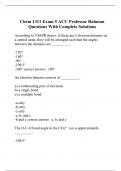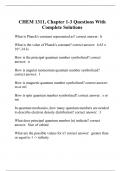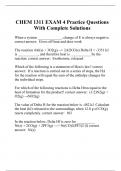CHEM 1311
Lamar State University
All 3 results
Sort by

-
Chem 1311 Exam 5 ACC Professor Rahman Questions With Complete Solutions
- Exam (elaborations) • 25 pages • 2023
-
Available in package deal
-
- $13.99
- + learn more
According to VSEPR theory, if there are 2 electron domains on a central atom, they will be arranged such that the angles between the domains are __________. -120° -180° -90° -109.5° -360° correct answer: 180° An electron domain consists of __________. a) a nonbonding pair of electrons b) a single bond c) a multiple bond -a only -b only -c only -a, b, and c -b and c correct answer: a, b, and c The O-C-O bond angle in the CO₃²⁻ ion is approximately ______...

-
CHEM 1311, Chapter 1-3 Questions With Complete Solutions
- Exam (elaborations) • 14 pages • 2023
-
Available in package deal
-
- $12.99
- + learn more
What is Planck's constant represented as? correct answer: h What is the value of Planck's constant? correct answer: 6.63 x 10^-34 Js How is the principal quantum number symbolized? correct answer: n How is angular momentum quantum number symbolized? correct answer: l How is magnetic quantum number symbolized? correct answer: m or mℓ How is spin quantum number symbolized? correct answer: s or ms In quantum mechanics, how many quantum numbers are needed to describe elec...

-
CHEM 1311 EXAM 4 Practice Questions With Complete Solutions
- Exam (elaborations) • 4 pages • 2023
-
Available in package deal
-
- $9.99
- + learn more
When a system _____________, change of E is always negative. correct answer: Gives off heat and does work The reaction 4Al(s) + 3O2(g) --> 2Al2O3(s) Delta H = -3351 kJ is ___________, and therefore heat is ___________ by the reaction. correct answer: Exothermic, released Which of the following is a statement of Hess's law? correct answer: If a reaction is carried out in a series of steps, the H∆ for the reaction will equal the sum of the enthalpy changes for the individual steps. ...

$6.50 for your textbook summary multiplied by 100 fellow students... Do the math: that's a lot of money! Don't be a thief of your own wallet and start uploading yours now. Discover all about earning on Stuvia


